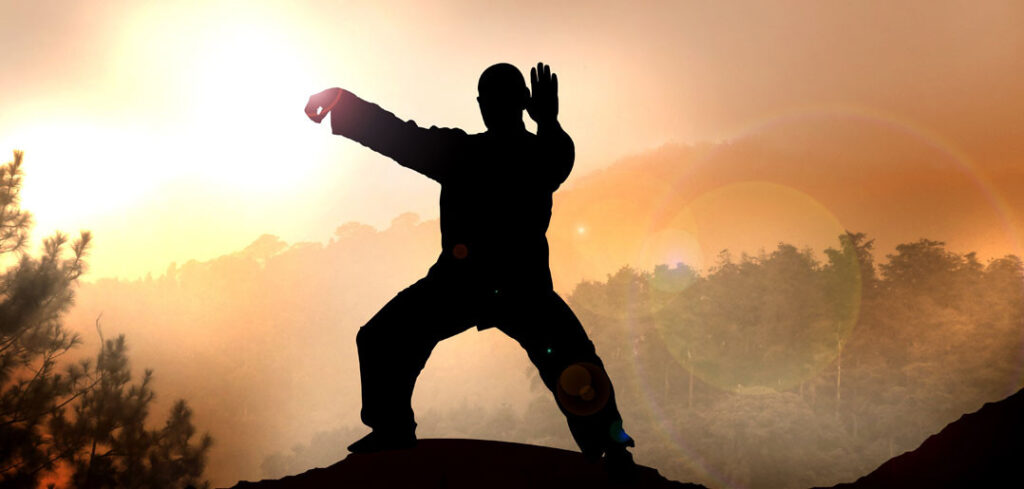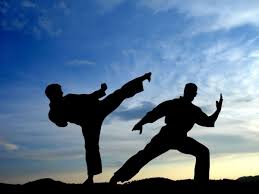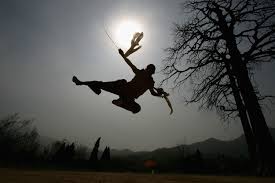Tai Chi: Article by Luke C Gregory as published in Blitz Magazine.
Many martial artists may not see tai chi – or tai-ji, as it’s called in China’s Mandarin tongue – as a true martial art, yet when practiced as originally intended, it becomes a powerful combat method. Tai-ji exponent Luke Gregory reports on the revival of combative tai-ji through the Xiao Wu system currently building momentum in China, and what it’s got that many others lack.

XiaO Wu’s Beginnings
Zhang Xiao Wu was born in Henan Province in December 1967. As a child he suffered from extreme Gastrointestinal problems, which, combined with a very poor diet, severely affected his health. He was emaciated and weak from the age of six, so at nine he began studying Qigong internal strengthening training with Zhang Fa Quan and Chen-style Tai-Ji Quan (tai chi) under Chen Zheng Lei, the current patriarch of Chen-style. Over the years he won many awards in China and led many students (including myself) to win Gold medals at international competitions on the mainland. He is particularly famous for his performances of Chen-style’s New-Fame-Second-Road form, the fastest, most aggressive and difficult one to perform. He has taught self-defense at many military academies, universities and martial-arts institutes throughout the People’s Republic of china (PRC). For the past nine years he has taught in Guangzhou in southern China, the last three at the famous TianHe Sports Center, TianHe, District, Guangzhou.
The original Tai-Ji Quan system is Chen-Style. In Wushu competitions in Mainland China, it is referred to as traditional Tai-Ji Quan. The method was devised by Chen Wang Ting (1600-1680) of Chen Jia Gou Village. Master Zhang is the official Guangzhou representative of Chen Jia Gou Village Tai-ji Martial Art association. He has also formed his own breakaway style; Xiao Wu Tai-Ji Quan and fitness cultivation system (Xiao Wu for short). As Master Zhangs’ Historical studies point out that Tai-ji Quan is essentially a striking art, the Xiao Wu System was established to emphasise real-time striking using relaxed power, both from a physical and tactical perspective. Master Zhang feels these elements are becoming lost in Chen-style teaching today.
The Truth About Qi
Chen and Xiao Wu Tai-Ji Quan are both ‘internal’ martial arts, meaning that practitioners focus to some degree on developing qi. The Mandarin (Chinese) character for qi has at least 12 different meanings (if you speak Mandarin you’ll understand why I say ‘at least’). Some we should ignore are: ‘gas’, ‘breath’, ‘odour’, ‘demeanour’, ‘morale, ‘loss of temper’, ‘annoy’ , ‘ bully’ and symptoms of a disease’. The relevant translation in this context is vital energy’. Upon encountering terms like this, most people either roll their eyes or get starry eyed and start talking about ancient wisdom. As a qualified linguist, I urge everybody to ignore dictionary translations and merely regard qi simply as qi – just borrow the word like we do with all the Latin and Greek medical expressions. If I write the word ‘pectoral’, people don’t go running to the dictionary to find any magical meanings. A pectoral muscle is simply that; a pectoral muscle. The word qi’s inception occurred before physical sciences knew what electricity was, so at the time it took on an element of mysticism.
Here is a simple explanation to soothe the pragmatists among us and separate Xiao Wu training theories from any limp, magical explanations: Our mental processes and our muscular movements occur as a result of chemical secretions and electronic impulses. One method of controlling these impulses is Qigong. The Chinese internal martial arts harness Qigong principles to provide combat solutions; it’s physiological science, not magic.
High-level practitioners of all martial arts use Qigong principles in their practice, intentionally or otherwise. It’s most likely intentional, but is referred to using different terminology. Simply put, it is high-level neuro-electronic impulse control, resulting from co-ordinating breath with postural concept. Those I’ve studied all require postures in which the quads, adductors, gracillus muscle and gluteus groups are used in a way that channels the body’s major weight-bearing duties to the latissimus dorsi and seratus muscle groups, with weight-bearing on the feet being highest at the heel. The many different schools of Qigong around the world use different names and different postural preferences.

The Xiao Wu Difference
While always respectful of Master Chens’ technique and very grateful for his excellent teaching over the years, Master Zhang found the modern Chen-style instruction in China focuses overly heavily on form training for its own sake, with minimal emphasis on the emission of relaxed power (Fa Jing). He feels this to be endemic to Tai chi Quan training the world over. Many readers studying internal styles may feel slighted and assert that they have indeed studied FA Jing. Obviously it is not my intention to offend any of my fellow martial artists, but in response to this assertion, I ask the following question:
- Is more then 25 per cent of your daily training related to real-time power emission?
- Can you perform the one-inch punch?
- Are you familiar with the sick-shaking techniques of Chen-style training, and are they a mandatory daily activity?
I would expect the answer to be negative in most cases: this is certainly so of the instructors I have studied under in the UK and Australia, and the many masters that I met within PRC, all of whom are highly regarded practitioners. Indeed, many of them are famous. Therefore, is it not safe to assume this is also the case elsewhere?
Practitioners of Xiao Wu Tai chi Quan can answer ‘yes’ to all the above questions. To illustrate this difference in learning/training priorities between styles: I recently spoke with a junior instructor of Chen-style who has trained with many instructors. She was very keen to find out from me how to do the shake-stick exercises. Despite the fundamental nature of these exercises to Chen-style Fa Jing training, according to her, neither she nor her friends – who study under both Chen Zhenglei and Chen XiaoWang – know how to do them. If there’s no force behind a strike, then the strike serves no purpose. If a strike has force but isn’t relaxed in delivery, then it will be slow and of little use.
There are three stick-shaking exercises: Dou gan, Pi Gan, and Beng Gan. Master Zhang focuses heavily on Dou Gan. The sticks used are usually 2.5-3.4 meters long and fatter at the base than at the tip. Six different grades of stick are used at the Guangzhou centre; the lightest being about 3cm thick at the base, 2cm at the tip , and 2.5m long with no spearhead, the heaviest being about 6cm at the base, 3cm at the tip, and about 3.4m long with a two-kilo spearhead. The sticks are all quite flexible.
To shake the stick, hold it in a bayonet grip and stand with feet a bit wider than shoulder-width apart, toes angled slightly forward with your rear hand holding the back end of the stick and your front hand about 50cm in front of your body. Your head turns over your shoulder, facing the sticks tip. Shift back into a cat-stance, pivoting on your back foot and turning your hips to face the stick’s tips (below, 1). Simultaneously bring your front hand back in a twisting motion to meet the back hand, also twisting motion to meet the back hand, also twisting, in front of the sternum in a wringing motion. Your back hand always remains at the base of the stick (below, 2). Reverse the process at speed by hurling your hips forward (below, 3) to make the tip of the stick violently shake horizontally (not vertically).
If performed incorrectly, this exercise can lead to lower-back injury, so it’s essential to start with a very light stick and get an expert to train you. When I was training in Guangzhou, people often challenged Shifu Xiao Wu’s skills. He would hand them the heavy stick, saying if they could shake it once they were worth listening to. Of at least 60 challengers, only a couple could do it. Unless the students of Tai chi Quan practices Stick-Shaking exercise, they cannot generate relaxed force. Those who are now indignant over my comments about their training regimes, I ask again, can you break a board with a one inch punch? If not, keep reading. Training regimes is the emphasis Xiao Wu places on mastery of the ji-ben gong (foundation training) techniques. Often these techniques are treated in the most perfunctory manner or they are completely overlooked. Without foundations, would your house still stand? Why is a pyramid fat at the bottom? A strong foundation is everything. Foundation training exists to facilities (among other things) neural connectivity. Neural connectivity comes from repetition and visualization. Being able to correctly visualize a movement comes from deeply considering every aspect of its delivery. Once the Neural connections have been made and sufficiently weighted, further movement can come from this basis.

The term ‘weighted’ is used in cognitive psychology to describe connections in the brain and nervous system (axons) that have been reinforced by repetition so they’re unlikely to disconnect. It’s then very unlikely the processes that caused the weighting will be forgotten and conscious thought is required less and less to access these movements, so the speed of the movement increases. Repetitive training causes muscle alignment/growth to occur in parallel with neural activity.
After the initial digestion of the fundamental movements, we’re no longer novices, we have become student. I hear so many people telling me of the many forms they ‘know’, only to find that the most basic of movement principles are incorrectly learned, performed and applied, or missing all together.
A very skillful, lifelong private student of Kazuo Sata (Shinbukan system) once told me “one good punch is worth a thousand bad ones”. Take a moment to consider this. At the time I was racing through my belts in ju-jitsu and I ‘knew’ hundreds of joint-rending, take down and striking techniques. My friend Steve claimed to only know about 50 techniques, but his understanding of them was full enough to apply them all under any circumstances. Neither I nor my other training buddies could touch him. Why? Because he had correctly internalized the fundamentals of his system while the rest of us were out collecting techniques. He had concepts, we had moves.
I recount this story to underline the importance of mastering fundamental movement concepts. As Wong Kiew Kit (Shaolin kung fu expert and author) says, “until a technique has been practiced 10.000 times, it has not been learnt”. A technique learned still needs practice to further refine and understand it, therefore the Xiao Wu system spends a long time on the fundamentals.
Tai Chi
In ji-ben gong training. Each of these movements incorporates a set of critical combat applications. It may sound esoteric, but consider the following notions:
- The shortest distance between two points is a straight line.
- When deflecting straight-line force, we know that circular movement applied at the right time, at the right angle will always work.
- When producing straight-line force, it’s possible to conceive every straight line the human body can produce as being part of a very big arc. Because Tai chi focuses so heavily on circular movement to generate power, many students mistakenly believe that all their movements must therefore be in a circular form. This contradicts point one (above), thus wasting time and adding distance requirements to attacking movements during combat. For example when launching a jab or lead-leg side-kick, the fist or heel don’t have to travel in a arc, they can take the shortest distance between launch and landing: a straight line. There are three ways to do this:
- Move the joints behind the weapon in circular motion to generate force, ie. describe an arc (turning on more than one plane) with the elbow and shoulder as the fist moves forward in a straight line.
- Visualize the straight strikes you’re doing as being produced in a circular fashion (ie. imagine the blow being powered by a super fast servo mechanism and feel the threading unwind down the limb into the target)
- Instead of visualizing which muscle initiates the movement, then following the chain of muscle tensions down the limb to the fist/foot (as I did when studying Japanese styles), think of a large, very shallow arc suddenly materializing length ways down the limb and viola, the strike has landed).
- When the human center of gravity is moving laterally in a straight line, with the extremities being powered by circular force emanating from the shoulders/waist/hips/knees (and given that force equals mass-times-velocity), the force at the extremities is as great as possible.
It isn’t always necessary to conceptualize these points in the above order, indeed often compress them all into simple phrase, ‘with every straight line is a circle waiting to get out’.
It is not my purpose to clarify any possible confusion about the above statements. Out job as students of the martial arts is to discover and internalize the truth in each so that we can become masters. Once these points are understood, we discover that every arc-like movement produced by every part of the body while performing every single fundamental technique in not only a defensive, re-directional movement, but also incorporates offensive capabilities.
Regarding those students who collect forms: people need to understand that the First Road of Chen training is a body-conditioning technique that loosens the joints, teaches balance/weighting and builds neural connections relating to moving dynamically while concurrently training the practitioner to use their breath to co-ordinate neuro-electronic impulses to create waves of energetic output. That’s a lot of conditioning! This can’t be achieved without understanding the constituent micro-movement concepts at a fundamental level. If the practitioner hasn’t correctly mastered the fundamentals of the movement system (ji-ben gong), they are just doing a calisthenic dance. Good for the body, but no more martial than boxercise and not as good as it could be.
Practitioners of Xiao Wu move their hi’s more than the other Chen exponents that I’ve seen. In the endless attempts at translating/decoding the various Tai chi Quan classic texts, I have frequently come across the phrase ‘…the waist is the messenger…’. From the experience I have of people tying to teach cryptic observation, they seen to get it wrong. It is not that the body pivots at the waist, rather, it is that while keeping the shoulders and the pelvis in the same position relative to each other, the waist follows the revolving action of the hips. At least, this is how we do it in Xiao Wu, and China’s most senior competition judges seem to agree with this approach. By moving in this way, it soon becomes that the bodies entire weight leads every movement, so that every deflection/strike delivers the momentum of body-weight combined with muscular output form the legs waist as a launching platform, instead of just using an isolated muscle group to generate force. This creates an effect similar to jumping into the space occupied by the part of an opponent being engaged. As such, the first thing an observer notices about Master Zhangs’ movements is that they have combat intentions.
Learn about tai chi, group fitness and training techniques in Fit Education’s Cert 3 in Fitness, Cert 4 in Fitness,and Diploma of Fitness.
